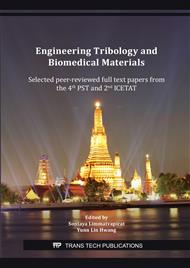p.98
p.104
p.111
p.117
p.123
p.129
p.137
p.144
p.153
Effect of Cisplatin/Curcumin-Loaded Polycaprolactone Nanoparticles on Oral Carcinoma Cells
Abstract:
This work aimed to investigate the effect of cisplatin (CDDP)/curcumin (Cur)-loaded polycaprolactone nanoparticles (PCL-NPs) on an oral epidermal carcinoma cell line. PCL-NPs were fabricated using nanoprecipitation method employing poly(vinyl alcohol) and polysorbate 80 as stabilizers. Two anticancer compounds, CDDP and Cur, were incorporated into the PCL-NPs by entrapment technique. The physical characteristics of the NPs were evaluated. The presence of the drugs on the NPs was ascertained using Attenuated total reflection Fourier-transformed infrared (ATR-FTIR) spectroscopy, and the drug content was quantified by indirect method using ultraviolet spectroscopy and inductive coupled plasma-mass spectroscopy. The cytotoxic effect was demonstrated using MTT assay and the synergistic effect of both drugs was calculated by the combination index method using CompuSyn® software. The findings revealed that the PCL-NPs were less than 300 nm with narrow size distribution. The appropriate drug concentration for drug loading was 0.12 mg/mL of Cur and 0.02 mg/mL of CDDP, providing approximately 70% and 80% loading efficacy, respectively. The improved anticancer effect was observed in the cells treated with mixture of the drugs and the NPs loaded with dual drugs. Above all, CDDP/Cur-loaded PCL-NPs were successfully prepared. The delivery system exhibited good anticancer effect against oral cancer cells which may be attributed to the synergism effect of CDDP and Cur loaded on the NPs.
Info:
Periodical:
Pages:
123-128
Citation:
Online since:
October 2021
Keywords:
Price:
Сopyright:
© 2021 Trans Tech Publications Ltd. All Rights Reserved
Share:
Citation:


